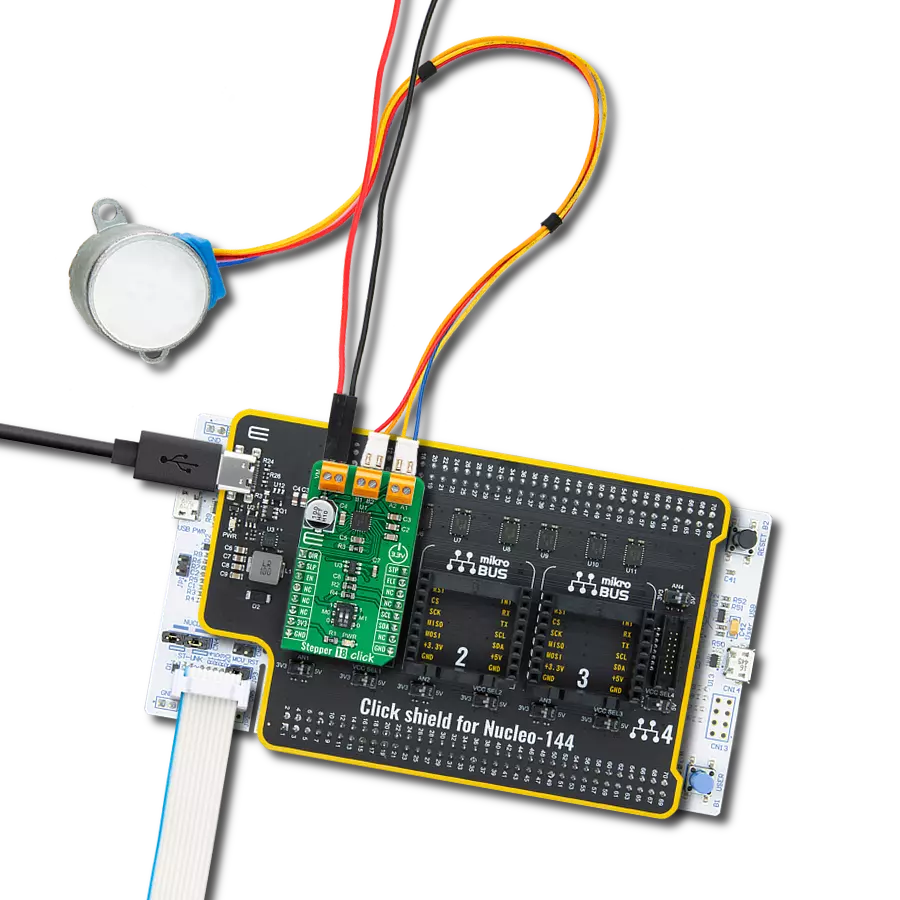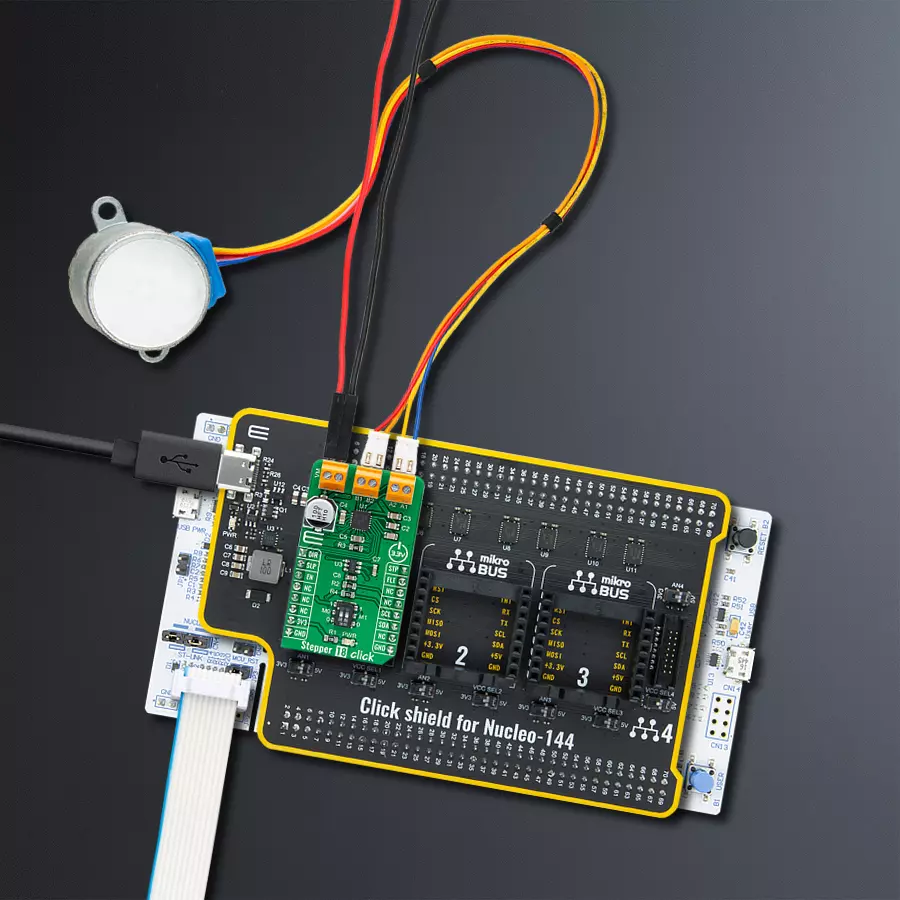Experience seamless motion control with our user-friendly integrated motor-driver solution, designed for bipolar stepper motors
A
A
Hardware Overview
How does it work?
Stepper 18 Click is based on the DRV8426, an integrated motor-driver solution for bipolar stepper motors with integrated current sense, 1/256 microstepping, STEP/DIR interface, and smart-tune technology Texas Instruments. It provides the maximum integration by integrating two N-channel power MOSFET H-bridges, current sense resistors and regulation circuitry, and a microstepping indexer capable of driving up to 1.5A full-scale output current. Stepper motor drivers need to re-circulate the winding current by implementing several decay modes, like slow, mixed, and fast decay. The DRV8426 comes with smart-tune decay modes, representing a decay mechanism that automatically adjusts for optimal current regulation performance agnostic of voltage, motor speed, variation, and aging effects. Along with this automatic smart-tune, DRV8426 provides traditional decay modes like slow-mixed and mixed decay. The voltage at the VREF pin adjusts the current regulation set-point obtained by the MCP4726, a 12-bit digital-to-analog converter from Microchip. Thus, the digital value is
converted to the appropriate voltage level (VCC) proportional to the received 12-bit number. The MCP4726 also integrates EEPROM for storing DAC register and configuration bit values and communicates with the MCU through the I2C 2-Wire interface supporting Standard (100 kHz), Fast (400 kHz), and High-Speed (3.4 MHz) I2C modes. In addition to I2C communication, the Stepper 18 Click communicates with MCU using several GPIO pins. A simple STEP/DIR interface, labeled as STP and DIR routed to the PWM and AN pins on the mikroBUS™ socket, allows MCU to manage the direction and step rate of the stepper motor. The internal microstepping indexer can execute high-accuracy microstepping without requiring the MCU to handle the winding current level. The indexer can achieve full step, half step, 1/4, 1/8, 1/16, 1/32, 1/64, 1/128, and 1/256 microstepping through the M0 and M1 pins routed to the onboard SMD switch. Also, high microstepping contributes to significant audible noise reduction and smooth motion. The Enable pin, labeled as EN and routed to the CS pin of the mikroBUS™ socket, optimizes
power consumption and is used for power ON/OFF purposes. All circuits, including the interface pins, are inactive in this state, and the DRV8426 is in the form of minimum power consumption. Also, a low-power Sleep feature is included, routed to the RST pin of the mikroBUS™ socket alongside the fault-interrupt feature routed to the INT pin of the mikroBUS™ socket. The Sleep Mode allows the system to save power when not actively driving the motor. This Click board™ supports an external power supply for the motor, which can be connected to the input terminal labeled as VM and should be within the range of 4.5V to 33V, while the stepper motor coils can be connected to the terminals labeled as A1, B2, B1, and A2. This Click board™ can be operated only with a 3.3V logic voltage level. The board must perform appropriate logic voltage level conversion before using MCUs with different logic levels. Also, it comes equipped with a library containing functions and an example code that can be used as a reference for further development.
Features overview
Development board
Nucleo-144 with STM32L4A6ZG MCU board offers an accessible and adaptable avenue for users to explore new ideas and construct prototypes. It allows users to tailor their experience by selecting from a range of performance and power consumption features offered by the STM32 microcontroller. With compatible boards, the
internal or external SMPS dramatically decreases power usage in Run mode. Including the ST Zio connector, expanding ARDUINO Uno V3 connectivity, and ST morpho headers facilitate easy expansion of the Nucleo open development platform. The integrated ST-LINK debugger/programmer enhances convenience by
eliminating the need for a separate probe. Moreover, the board is accompanied by comprehensive free software libraries and examples within the STM32Cube MCU Package, further enhancing its utility and value.
Microcontroller Overview
MCU Card / MCU

Architecture
ARM Cortex-M4
MCU Memory (KB)
1024
Silicon Vendor
STMicroelectronics
Pin count
144
RAM (Bytes)
327680
You complete me!
Accessories
Click Shield for Nucleo-144 comes equipped with four mikroBUS™ sockets, with one in the form of a Shuttle connector, allowing all the Click board™ devices to be interfaced with the STM32 Nucleo-144 board with no effort. This way, MIKROE allows its users to add any functionality from our ever-growing range of Click boards™, such as WiFi, GSM, GPS, Bluetooth, ZigBee, environmental sensors, LEDs, speech recognition, motor control, movement sensors, and many more. Featuring an ARM Cortex-M microcontroller, 144 pins, and Arduino™ compatibility, the STM32 Nucleo-144 board offers limitless possibilities for prototyping and creating diverse applications. These boards are controlled and powered conveniently through a USB connection to program and efficiently debug the Nucleo-144 board out of the box, with an additional USB cable connected to the USB mini port on the board. Simplify your project development with the integrated ST-Link debugger and unleash creativity using the extensive I/O options and expansion capabilities. This Click Shield also has several switches that perform functions such as selecting the logic levels of analog signals on mikroBUS™ sockets and selecting logic voltage levels of the mikroBUS™ sockets themselves. Besides, the user is offered the possibility of using any Click board™ with the help of existing bidirectional level-shifting voltage translators, regardless of whether the Click board™ operates at a 3.3V or 5V logic voltage level. Once you connect the STM32 Nucleo-144 board with our Click Shield for Nucleo-144, you can access hundreds of Click boards™, working with 3.3V or 5V logic voltage levels.
The 28BYJ-48 is an adaptable 5VDC stepper motor with a compact design, ideal for various applications. It features four phases, a speed variation ratio of 1/64, and a stride angle of 5.625°/64 steps, allowing precise control. The motor operates at a frequency of 100Hz and has a DC resistance of 50Ω ±7% at 25°C. It boasts an idle in-traction frequency greater than 600Hz and an idle out-traction frequency exceeding 1000Hz, ensuring reliability in different scenarios. With a self-positioning torque and in-traction torque both exceeding 34.3mN.m at 120Hz, the 28BYJ-48 offers robust performance. Its friction torque ranges from 600 to 1200 gf.cm, while the pull-in torque is 300 gf.cm. This motor makes a reliable and efficient choice for your stepper motor needs.
Used MCU Pins
mikroBUS™ mapper
Take a closer look
Click board™ Schematic

Step by step
Project assembly
Track your results in real time
Application Output
1. Application Output - In Debug mode, the 'Application Output' window enables real-time data monitoring, offering direct insight into execution results. Ensure proper data display by configuring the environment correctly using the provided tutorial.

2. UART Terminal - Use the UART Terminal to monitor data transmission via a USB to UART converter, allowing direct communication between the Click board™ and your development system. Configure the baud rate and other serial settings according to your project's requirements to ensure proper functionality. For step-by-step setup instructions, refer to the provided tutorial.

3. Plot Output - The Plot feature offers a powerful way to visualize real-time sensor data, enabling trend analysis, debugging, and comparison of multiple data points. To set it up correctly, follow the provided tutorial, which includes a step-by-step example of using the Plot feature to display Click board™ readings. To use the Plot feature in your code, use the function: plot(*insert_graph_name*, variable_name);. This is a general format, and it is up to the user to replace 'insert_graph_name' with the actual graph name and 'variable_name' with the parameter to be displayed.

Software Support
Library Description
This library contains API for Stepper 18 Click driver.
Key functions:
stepper18_set_out_voltage- Set voltage reference.stepper18_set_dir- Set direction.stepper18_move_motor_angle- Move motor in angle value.
Open Source
Code example
The complete application code and a ready-to-use project are available through the NECTO Studio Package Manager for direct installation in the NECTO Studio. The application code can also be found on the MIKROE GitHub account.
/*!
* @file main.c
* @brief Stepper18 Click example
*
* # Description
* This example showcases the device's ability to control the motor.
* It initializes the device for control and moves the motor in two
* directions in a variety of speeds for 360 degrees.
*
* The demo application is composed of two sections :
*
* ## Application Init
* Initializes UART and I2C communication modules, and additional
* pins for motor control, and set's default configuration
*
* ## Application Task
* First it move motor clockwise for 360 degrees in medium speed.
* Then changes direction and moves motor for 180 degrees in slow speed,
* and additional 180 degrees in fast speed.
*
* @note
* Step resolution is changed by the switches[ M0, M1 ] on device.
* Full step : M0=>0 , M1=>0
* Half step : M0=>1 , M1=>0
* Quarter step : M0=>0 , M1=>1
* 1/8 step : M0=>1 , M1=>1
* 1/16 step : M0=>Hi-Z , M1=>1
* 1/32 step : M0=>0 , M1=>Hi-Z
* 1/64 step : M0=>Hi-Z , M1=>0
* 1/128 step : M0=>Hi-Z , M1=>Hi-Z
* 1/256 step : M0=>1 , M1=>0
*
* @author Luka Filipovic
*
*/
#include "board.h"
#include "log.h"
#include "stepper18.h"
static stepper18_t stepper18;
static log_t logger;
void application_init ( void )
{
log_cfg_t log_cfg; /**< Logger config object. */
stepper18_cfg_t stepper18_cfg; /**< Click config object. */
/**
* Logger initialization.
* Default baud rate: 115200
* Default log level: LOG_LEVEL_DEBUG
* @note If USB_UART_RX and USB_UART_TX
* are defined as HAL_PIN_NC, you will
* need to define them manually for log to work.
* See @b LOG_MAP_USB_UART macro definition for detailed explanation.
*/
LOG_MAP_USB_UART( log_cfg );
log_init( &logger, &log_cfg );
log_info( &logger, " Application Init " );
// Click initialization.
stepper18_cfg_setup( &stepper18_cfg );
STEPPER18_MAP_MIKROBUS( stepper18_cfg, MIKROBUS_1 );
err_t init_flag = stepper18_init( &stepper18, &stepper18_cfg );
if ( init_flag == I2C_MASTER_ERROR )
{
log_error( &logger, " Application Init Error. " );
log_info( &logger, " Please, run program again... " );
for ( ; ; );
}
stepper18_default_cfg ( &stepper18 );
log_info( &logger, " Application Task " );
stepper18_set_dir( &stepper18, 0 );
}
void application_task ( void )
{
static uint8_t direction = 0;
log_printf( &logger, "> Move 360deg in CW direction.\r\n" );
stepper18_move_motor_angle( &stepper18, 360, STEPPER18_STEP_RES_FULL, STEPPER18_SPEED_MEDIUM );
direction = !direction;
stepper18_set_dir( &stepper18, direction );
Delay_ms ( 500 );
log_printf( &logger, "> Move 180deg in CCW direction.\r\n" );
stepper18_move_motor_angle( &stepper18, 180, STEPPER18_STEP_RES_FULL, STEPPER18_SPEED_SLOW );
Delay_ms ( 1000 );
log_printf( &logger, "> Move 180deg in CCW direcion.\r\n" );
stepper18_move_motor_angle( &stepper18, 180, STEPPER18_STEP_RES_FULL, STEPPER18_SPEED_FAST );
direction = !direction;
stepper18_set_dir( &stepper18, direction );
Delay_ms ( 1000 );
Delay_ms ( 1000 );
}
int main ( void )
{
/* Do not remove this line or clock might not be set correctly. */
#ifdef PREINIT_SUPPORTED
preinit();
#endif
application_init( );
for ( ; ; )
{
application_task( );
}
return 0;
}
// ------------------------------------------------------------------------ END



































